
Star Wars: X-Wing vs. TIE Fighter is a 1997 space combat game developed by Totally Games for LucasArts. It is the third installment of the X-Wing series.

Star Wars: Force Commander is a real-time strategy video game released for the Microsoft Windows platform in 2000. It was co-developed by Ronin Entertainment and LucasArts, and published by LucasArts. Its plot interweaves between Star Wars: A New Hope and Return of the Jedi, taking place in key battles. Peter McConnell created remixed tracks of John Williams's original score with influences from hard rock and techno music.

Star Wars: Empire at War is a 2006 real-time strategy video game developed by Petroglyph Games and published by LucasArts for Microsoft Windows and Mac OS X. Set between Episode III and Episode IV, it focuses on the fledgling struggle between the Empire and the Rebels. It uses Petroglyph's game engine Alamo. In October 2006, an expansion titled Star Wars: Empire at War: Forces of Corruption was released. On May 31, 2014, online functionality, including network multiplayer and wireless chat, was discontinued after Glu Mobile's purchase of GameSpy and the subsequent shutdown of all game servers. As of September 1, 2017, the multiplayer has been re-enabled on the Steam version with Workshop support added.
Star Wars: Rogue Squadron is a series of Star Wars action video games jointly developed by LucasArts and Factor 5 and published by LucasArts for Nintendo consoles. Aspyr has expressed interest in bringing the series to the Nintendo Switch.

Star Wars Rogue Squadron II: Rogue Leader is an action game co-developed by Factor 5 and LucasArts and is the second of the Rogue Squadron series. It was published by LucasArts and released as a launch title for the GameCube in North America on November 18, 2001, and Europe on May 3, 2002. Set in the fictional Star Wars galaxy, the game spans all three original trilogy Star Wars films. The player controls either Luke Skywalker or Wedge Antilles. As the game progresses, Skywalker, Antilles and the Rebel Alliance fight the Galactic Empire in ten missions across various planets.

Over one hundred video games based on the Star Wars franchise have been released, dating back to some of the earliest home consoles. Some are based directly on films while others rely heavily on the Star Wars Expanded Universe.
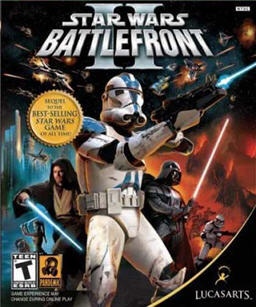
Star Wars: Battlefront II is a 2005 first and third-person shooter video game based on the Star Wars film franchise. Developed by Pandemic Studios and published by LucasArts, it is a sequel to 2004's Star Wars: Battlefront and the second installment in the Star Wars: Battlefront series. The game was released in PAL regions on October 28, 2005, on the PlayStation 2, PlayStation Portable (PSP), Microsoft Windows, and Xbox platforms, and in North America on November 1 of the same year. It was released on the PlayStation Store on October 20, 2009, for download on the PSP. The PSP version was developed by Savage Entertainment.

Star Wars Rogue Squadron III: Rebel Strike is an action video game developed by Factor 5 and published by LucasArts for the GameCube. The game is set during the original Star Wars trilogy and recreates battles that take place during those films. The game follows Rogue Squadron, which, under the command of Luke Skywalker and Wedge Antilles, uses starfighters to engage and defeat the Galactic Empire.
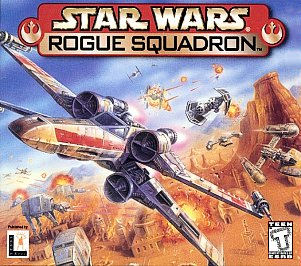
Star Wars: Rogue Squadron is an arcade-style flight action game co-developed by Factor 5 and LucasArts. The first of three games in the Rogue Squadron series, it was published by LucasArts and Nintendo and released for Microsoft Windows and Nintendo 64 in December 1998. The game's story was influenced by the Star Wars: X-wing – Rogue Squadron comics and is set in the fictional Star Wars galaxy, taking place primarily between events in the films Star Wars and The Empire Strikes Back. The player controls Luke Skywalker, commander of the elite X-wing pilots known as Rogue Squadron. As the game progresses, Skywalker and Rogue Squadron fight the Galactic Empire in 16 missions across various planets.

Star Wars: The Force Unleashed is an action-adventure game developed and published by LucasArts, and part of The Force Unleashed multimedia project. It was initially developed for the PlayStation 2, PlayStation 3, Wii, and Xbox 360 consoles and on iOS, second-generation N-Gage, Nintendo DS, PlayStation Portable, and Java-equipped mobile phone handhelds. The game was released in North America on September 16, 2008, in Australia and Southeast Asia on September 17, and in Europe on September 19. LucasArts released downloadable content for the PlayStation 3 and Xbox 360 consoles. An Ultimate Sith Edition of the game, containing both new and previously released downloadable content, was released in November 2009, and later ported to the macOS and Microsoft Windows. An enhanced remaster of the Wii version, developed by Aspyr, was released on Nintendo Switch on April 20, 2022.
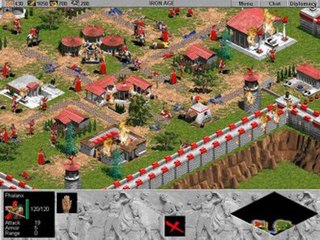
The Genie Engine is a game engine developed by Ensemble Studios and used in several computer games, such as Age of Empires, Age of Empires II and its expansions and Star Wars: Galactic Battlegrounds. Some of those games have been ported to the Apple Mac.

Aliens vs. Predator: Requiem is a 2007 action game exclusive to the PlayStation Portable, developed by Rebellion Developments and published by Vivendi Games. It was released in November 2007 in North America and Europe, and December 2007 in Australia. It is part of the Alien vs. Predator franchise, an amalgamation of the Alien and Predator franchises. Aliens vs. Predator: Requiem is a tie-in to the film of the same title, which was released shortly after the game.
Star Wars: Battlefront is a series of first- and third-person shooter video games based on the Star Wars franchise. Players take the role of characters from the franchise in either of two opposing factions in different time periods of the Star Wars universe. The series was launched in 2004 by LucasArts with Star Wars: Battlefront, developed by Pandemic Studios for LucasArts. The game received positive reviews and sold well. In 2005 Pandemic developed a sequel, Star Wars: Battlefront II, which was also critically and commercially successful.
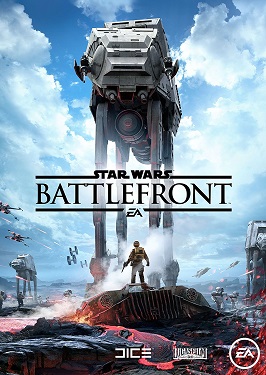
Star Wars Battlefront is an action shooter video game developed by DICE, with additional work from Criterion Games, and published by Electronic Arts in November 2015. The game, based on the Star Wars film franchise, is the third major release in the Star Wars: Battlefront sub-series, but is considered a reboot to the previous games, instead of a sequel, to reflect the new Star Wars canon that Lucasfilm established after being acquired by The Walt Disney Company.

Star Wars: Battlefront is a 2004 first and third-person shooter video game based on the Star Wars film franchise. Developed by Pandemic Studios and published by LucasArts, it is the first installment in the Star Wars: Battlefront series. It was released on September 21, 2004, for PlayStation 2, Xbox and Microsoft Windows to coincide the release of the Star Wars Trilogy DVD set. Aspyr released a Mac OS X port in July 2005, and a cellular phone version, Star Wars Battlefront Mobile, was released on November 1, 2005.

Star Wars Battlefront: Elite Squadron is a third-person shooter video game based on the Star Wars franchise. It the fourth installment in the Star Wars: Battlefront series, and the second handheld exclusive, after Star Wars Battlefront: Renegade Squadron. It was released on November 3, 2009, in North America and November 6 in Europe, for the Nintendo DS and PlayStation Portable.
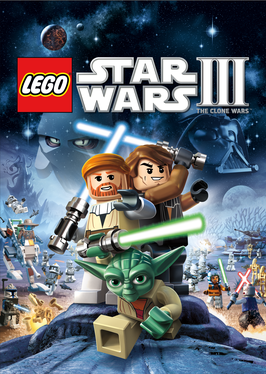
Lego Star Wars III: The Clone Wars is a Lego-themed action-adventure video game developed by Traveller's Tales and published by LucasArts in March 2011 for the PlayStation 3, PlayStation Portable, Xbox 360, Wii, Nintendo DS, Microsoft Windows, and the Nintendo 3DS. It was one of the 3DS's launch titles. The game features missions and characters from the 2008 animated film Star Wars: The Clone Wars and its follow-up television series, as well as fan-favorites from the original Star Wars saga, in both single-player and multiplayer gameplay modes. The Mac OS X version of the game was released by Feral Interactive.
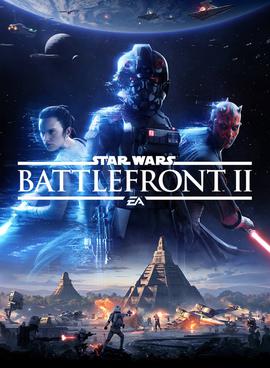
Star Wars Battlefront II is an action shooter video game based on the Star Wars franchise. It is the fourth main installment of the Star Wars: Battlefront series, and a sequel to the 2015 reboot of the series. It was developed by DICE, in collaboration with Criterion Games and Motive Studios, and published by Electronic Arts. The game was released worldwide on November 17, 2017, for the PlayStation 4, Windows, and Xbox One. The game features both single-player and multiplayer modes, and overall includes more content than its predecessor. The single-player campaign of the game is set between the films Return of the Jedi and The Force Awakens, and follows an original character, Iden Versio, the commander of an Imperial special ops strike force dubbed Inferno Squad, who defects to the New Republic after becoming disillusioned with the Galactic Empire's tactics. Most of the story takes place during the final year of the Galactic Civil War, before the Empire's definitive defeat at the Battle of Jakku.

Iden Versio is a fictional character in the Star Wars franchise. She is the commander of Inferno Squad, a group of elite Imperial soldiers, who eventually defects to the Rebel Alliance. Iden is the player character of the 2017 video game Star Wars Battlefront II, an action shooter developed by EA DICE, in collaboration with Criterion Games and Motive Studios. She serves as the main protagonist of the game's single-player campaign, in which she is voiced and portrayed via motion capture by Janina Gavankar.


















